So I have a confession: my horses work for a living. Or I make them work for a living. Or they choose to work for me so that I can continue to buy them hay. Or we co-create experiences for people that I am compensated for.
Do you see how we are already trapped by the language here? Do I MAKE them work? Do they choose to? Is the concept of livelihood something we have a right to impose upon another living being? Can I ever say that the agreement I have with my horses is one they have agency in, when I have a student waiting who has paid me for their right to have expectations?
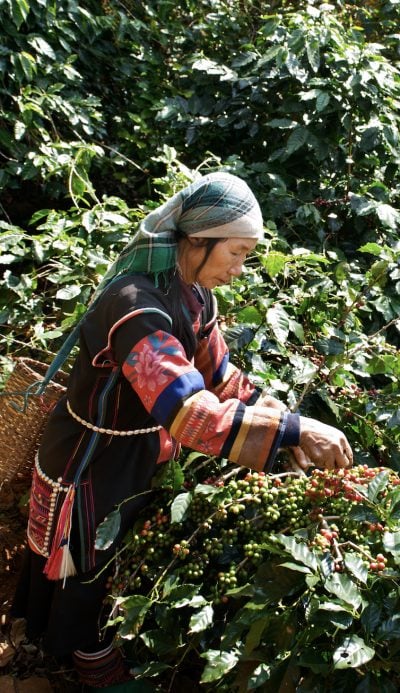
Sometimes I feel like I have a very rigid, vegan animal rights activist living in a room inside my brain. The room is papered with posters that have been hung with wheat paste. No glue because, you know… She is the one who goes to auctions and buys calves so they can live out the rest of their lives in pastures full of lush grass. She has no understanding of the concept that the calves needed to be sold in order for the farmer to be able to put a new roof on her barn and buy hay to feed the rest of her herd through the winter. To be honest, this vegan activist’s ethics feel unattainable. At least until I am independently wealthy and can offer my horses a living wage just to stand around in their field and swish their tails and dream of a time when they will be free to run down the streets of a crumbling dystopian America. This vegan activist says crazy things like you must brush them only with soft brushes but NEVER when they are napping, and keep the radio tuned to classical strings at all times, it makes them feel as if the wind is blowing through their manes… Sometimes I am grateful that she is there, because she balances out the weight of the belief system we are all trying to escape from, the one that says animals were placed here on the the earth for us to use as we see fit, and the horse must do as I say. Yuck.
Of course there is a balance that lies between these extremes. But like everything that exists on a balance point, I find that I am continually falling off of that point, and making my way back to it over and over again. That’s the nature of balance, it’s a dynamic thing. Which means that it possesses a livingness all of its own, and the farther I go in chasing it, the closer it comes in toward me. Which reminds me of Rumi’s line; “what you seek is also seeking you.” Well, thank friggin’ goodness I’m not alone over here then!
I could begin by telling you about me and how things came to be this way, but really I would rather tell you about Dublin.

Dublin is a 16.2 hh Belgian/Warmblood cross. When I found him he was being boarded at a barn where he was in a stall with a 16′ by 12′ outdoor pen attached to it. I’d had a couple of rides on him and he seemed honest enough- though there was something sour about his expression that told me not to ask for too much, that humans had already taken more than he had been willing to give. The girl who was training him told me he was probably going to get sent to auction, as he had bucked her off again at their last show. I looked at him again. Could imagine just how he felt about horse shows. All that expectation and pressure and effort– and for what??! Hmmmmppph. I told her I would give her a thousand dollars for him. Something about his closed down eye made me want to see if I could make it sparkle again.
The next day, the girl’s mother told me she would accept my offer. I laughed. There was probably $20 in my bank account. But then my income tax return came in and it was just enough to buy him and a week’s worth of hay. I remember riding my bike to Home Depot the day I bought him and filling my traveling backpack with those compressed sawdust stove pellets so I would have some bedding to put down in his stall.
I rode him out on the trails for two months solid. Just put miles and miles into him, trying to straighten out whatever it was in his head that made him buck. To put some basic muscle and tendon strength into him. His previous owners had already done vet assessments out the wazoo, so I didn’t feel it was worth taking out a loan to pursue that. I had an equine bodyworker look at him, and she told me there was nothing going on with him physically. So I worked with his mind instead, just trying to get him moving, so that whatever had lodged in him could work its way out of his system. Sometimes I rode and sometimes I walked beside him or drove him ahead of me on long lines. I took him into rivers, to Tim Hortons, to the farmer’s market to meet crowds of kids, and through downtown Squamish to jump logs at Nexen Beach when the tide was out. Just really exposed him everything.
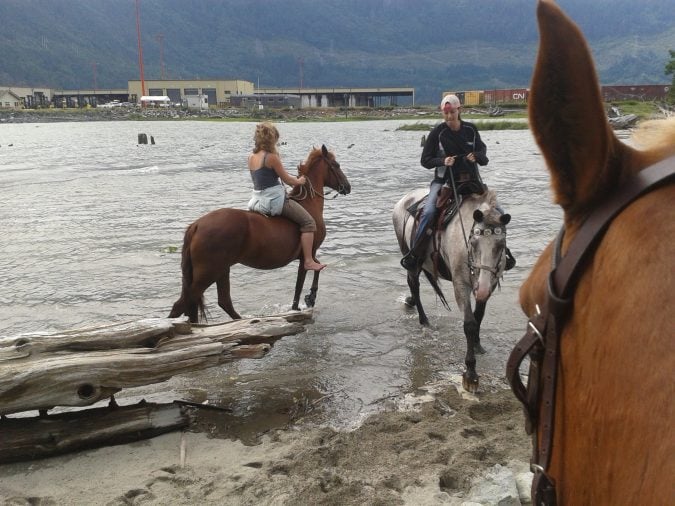
I wanted him to know who I was and what his new life might be like, and this was the best way I had of showing him. After two months of unschooling, I registered Mountain Horse School, took out an insurance policy, and started to teach lessons on Dublin. I was terrified of teaching. I knew that my experience would hold, and that I would have to trust that the words would come. And they did. Something told me that it was time to make the leap, and to create some structure to hold me there until I figured out where I had landed. Plus, I could not afford to have a horse. I should not have bought a horse in the first place. But it wasn’t really my decision at that point, it was Dublin’s. So I figured that since we were in this process together and we both had to eat, he could help me out a little.
My first students were tiny little 6 year olds, mounted way, way up on this great big horse. I taught out on the trail a lot because Dublin was still so sour in the ring. I could coax maybe 10 minutes out of him in there, and then his nostrils would start to crinkle up and his body would start to bow to the outside and instead of taking a chance on what might come next, I would open the gate and let us out into the world. So right from the beginning the way that I taught was more experiential than lesson based. And man, did it teach me to listen to my horse. I relied on Dublin’s senses to tell me when a bear was going to pop out of the trees, and he relied on me to let him know that the kevlar clad mountain biker speeding by his left shoulder was not going to eat him for lunch. The first thing I taught anyone who rode with me was something I called a ‘stop breath.’ The first few times I would make them halt and close their eyes, and then drop their weight and energy down into the horse’s body through a deep exhalation, imagining that they were breathing through their own body into the horse’s body and then through his hooves into the ground. Eventually all I had to say was ‘STOP BREATH!’ and they could do it in a second or two. This became Dublin’s cue to halt, a handy tool we could use to de-escelate any situation we might run into, AND a way to get excited or nervous riders to come back into their bodies fast without having to say too many words.
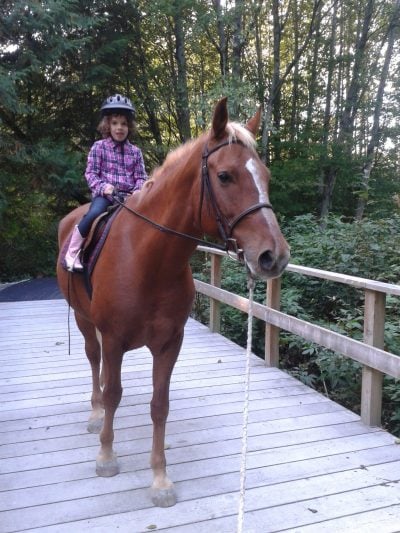
I kept the little kids on a rope when we were out even once they learned to steer, as Dublin was so big and could easily pull the reins out of their hands if he dove for a patch of ferns. The rope also gave me a direct line in to him even when it was slack. It turned us into a team. I wasn’t just there on the ground yelling instructions from the middle of the ring, I was part of the experience.
Dublin seemed to be okay with it. He would still make snarly grouchy faces when I rode him in the ring (I still do something that looks like schooling from time to time) but working with students in this way, especially the kids, he seemed to be ok with. And that was important because if he was not happy things could go sideways really fast. One moment he would be on your side, and the next he wouldn’t. So he taught me not only to listen, but to take him seriously. Every. Single. Time.
“That horse is just an asshole” one of his old trainers said to me once.
“I think he has a really strong sense of justice” I told her.
The riding lessons were just getting my toes wet for the real work I wanted to do, which was to work with kids with autism on horseback. It took me another two years to be ready. But during the summer in Squamish Valley, when I really dove in, it was Dublin who carried us. There were two brothers in particular, both on the spectrum, who he absolutely loved. He would position himself so that his muzzle was held protectively over their heads when they stood in the ground. One of the boys, Justin, fell asleep on his back. “He is never still,” his mom told me, “Never.” Dublin’s extraordinary sense of humour started to come out. He taught himself how to drink out of coffeecups, and to throw his bucket across the driveway when he was done eating. He would sneak up on me when I crossed the field in the dark, and reach for my ear with his lips. Aggghhhh!

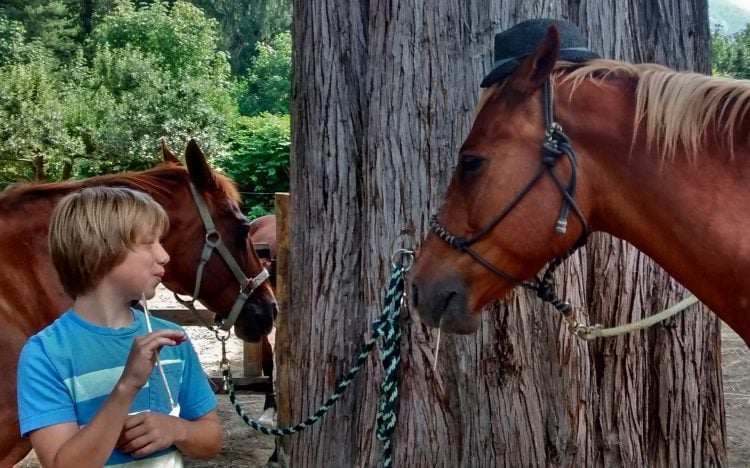
I continued to teach regular lessons on Dublin too. Every now and then he would bust out his old snarly grumpy show horse face and I would know it was time for me to take him out on an adventure somewhere and have a listen to his body to see what was going on. Even now, I still cannot teach on him without riding him in between lessons. (It can’t be right before lessons, as he likes to have a break in between. Remember that strong sense of justice I mentioned? It’s still a real thing.) It’s almost like parts of him get tangled up by what he picks up from students, and moving around in the field with the other horses isn’t enough to undo the knots.
My role as a rider has become almost more like that of a sculptor, feeling for those little inconsistencies in the way he moves – the places where energy gets trapped the way logjams trap the current of a river – and working them out. Yes, it is my job to make sure he is physically sound and fit enough to be comfortable. It’s also my job to give him a basic behavioural framework he can work within, so I can trust that he will take care of someone when I put them on his back. So in between our work together, we go out on the roads or trails and I feel for the places where the flow of energy in him gets caught up… and untangle it.
And then when Dublin and I teach together, our lessons become experiences of how to manage the flow of energy that the horse makes available to you; first how to let it move through you, and then how to sculpt it in a particular direction. I can’t use this language with the 6-year-olds of course, but the experience they take away from it is still the same.
When I think about myself and my own relationship to movement, I can relate. I absolutely HATE sports. (Balls? Why would I run around and chase them? I am not a dog.) But I know that if I wake up a little grumpy or sore or disassociated or feel like my energy is flowing backwards (or that weird combo of all of the above that always makes me think of the Spiritualized album, Ladies and Gentlemen, We Are Floating in Space) then the solution is to put on some shoes and go outside and dribble my way towards whatever task is next on my list of my big muscle jobs. I might start out very clumsily, but part way through whatever started the rebellion in my interior landscape is back on my side, happily digging up old railway ties or scooping poo or whatever. And usually by the time I stop, the boundaries of the physical world have been put back in order. I know again where I am, and where I am not.
We are embarking on our 6th year together, Dublin and I. And still, every day is different. Each time we teach is different, because what emerges is a result of all of our combined energies: his, mine, and our student’s. And because I would really like to give you an example of what this looks like, let me walk you through what we did today:
This morning I caught a look in Dublin’s eye – a look that says PAY ATTENTION. I think back over the work we’ve been doing together lately, and realize I have been using him to pony my green mare the last few times I have ridden him, and that really he needs a date just with me. And so we go out across Millar creek and he trips and stumbles and lugs along. His body under me feels stiff as a piece of old lumber. WAKE UP!! I shout at him with my body. WAKE UP!! I send him around the beaver pond at a trot until the terrain and the beavers’ felled trees collect him up for me, reminding him he can be light on his feet. After we come up the hill onto the Dyke, I put him into a canter. Supporting, holding, directing, waiting for the energy coming from him to move straight. And when it does we stop, and he starts to snort. And not just his regular snorts, but the ones that come with a set of long groans made on the exhalation that means we really got the stickiness out. Whatever it was that had turned him into a heavy equine marshmallow. ‘Uhhhhhnnnngggggguuuuhhhhhhh‘ Dublin groans. And I know we have made it through to that state that I feel after a yoga class when every part of my body sings, when I feel as if my feet and my mind and my heart have come into the same place and that it is good.
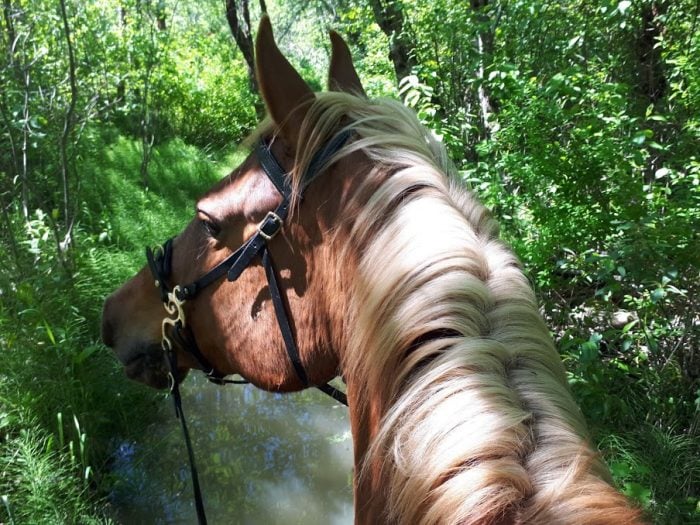
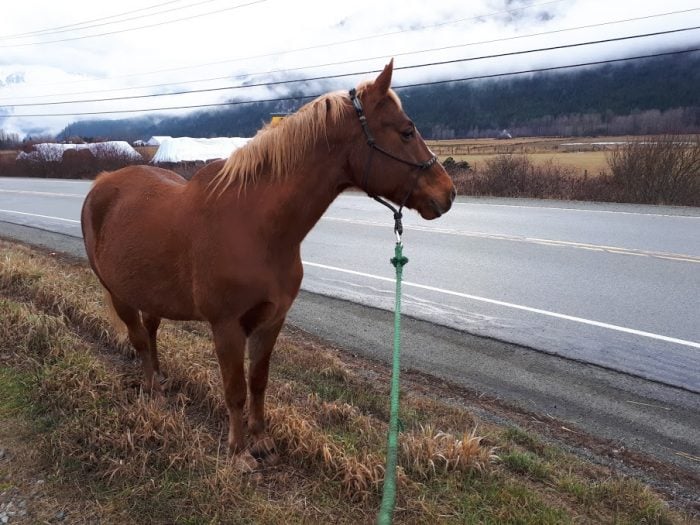
Four hours later, I teach a lesson on him for one of my longtime students who is just beginning canter work. I avoid teaching canter on this horse because he is SO hard. He is so large and his reactions are so slow, but he is so sensitive to weight shifts at the same time, that it makes for a really tricky combo. He can truck around at walk and trot for hours, but if you ask for even a step of canter then all of the old trauma from his show horse days wakes up and enters his body and it takes a great deal of patience and deep breathing and balance and centredness to ride him through it. I begin with no plan, other than that we will attempt to brush against canter at some point. As we warm up, I have my student concentrate on letting her body be soft and strong at the same time: soft hands, soft wrists, soft elbows, soft ankles. Letting everything be fluid, so she can ride with the intelligence of her bones. We get to the part where I would like to have her ask Dublin to canter, and it is as if he can hear my thoughts, because he twists right up into a counter bent pretzel. “Just carry on,” I tell my student, “we are going to proceed calmly and fairly and we are not going to get upset. We are going to give him time to realize that nothing is happening. Don’t take his reaction personally. Just stay with him. Stay with the process. Support him. Don’t get scared and don’t match his intensity. Just wait for him. Ride it out.” I go quiet for a few moments, waiting to see if Dublin is willing to settle. Watching to see if my student’s stability in her own nervous system can settle him.
“You have just made the transition from a rider who thinks about how she looks on a horse and how she can stay on, to a rider who thinks about what the horse is doing under her and how she can help him. This is a HUGE thing. Don’t expect too much to happen right away. Just wait. Keep breathing. Don’t get tight.”
I watch Dublin settle under her, watch whatever it is that rose up in him fall away, “Ok, now! Now ask him. Step into your left stirrup and imagine him lifting under you, almost as if he is going to fly.”
They get it, a few strides of flowing, balanced canter, with her body soft and Dublin’s body soft, offering her the movement. That is enough for now, “Stop, stop, give him a long rein and pet him. Tell him how wonderful he is.” And we go for a walk around the back field to give them both some time to process.
“This is really good practice for you, because it gives you a small taste of being uncomfortable and gives you an arsenal of tools to move through it. To not react. To give the horse time to form a different response” I tell her. “It’s giving you a chance to really feel what is happening. This will work for you in life too, these feelings you are learning to master.” It’s not like I think up these things that I say. They come out the moment that we share together, come out of the space that exists between Dublin and I.
“I really liked what you said about not taking it personally.”
“Well, that works for everything you’re ever going to encounter, doesn’t it?”
She laughs.
‘Uhhhhhnnnngggggguuuuhhhhhhh‘ Dublin groans. And snorts a big snotty snort all over my face. And I would feel alright with leaving you here, at least for now, except that…
Wait! The vegan activist is awake again, in the room inside my head. She points to a poster she has pasted on the wall that shows a horse’s skeleton with a rider on it. The horse’s ears are pinned and its face wears a pained expression. What about the damage our weight does to the horse’s spine, what about its back muscles going numb, what about BITS??!! she shouts at me.
“There, there…” I hand her a flax egg cookie and a new graphic novel to read, “We’ll get to that eventually. That’s my old mare Sarah’s part of the story.”
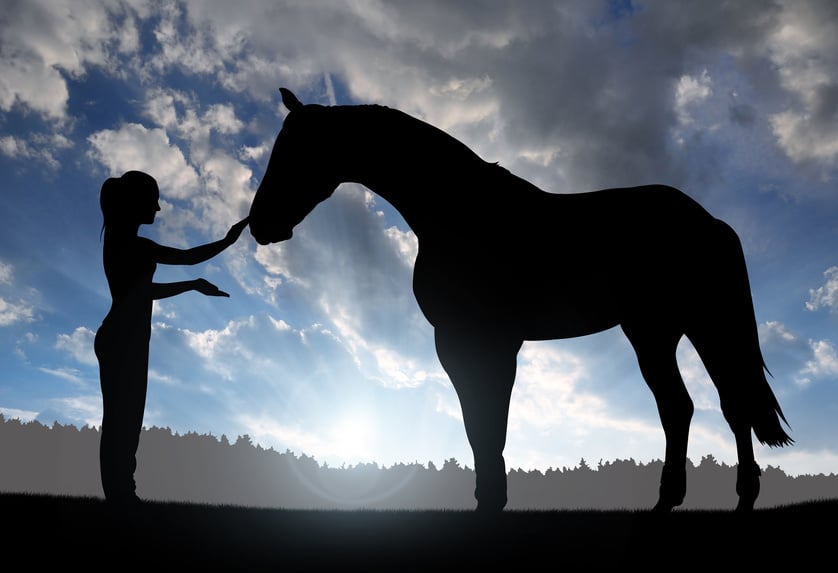
Special stories and experiences from fellow horse listeners








This was a lovely read. Horses just elicit all the spectrum of emotions…don’t they? I too…have so many sides (I like your version…rooms in my head) to my brain and thoughts about the flow and balance with horses. The main theme of your story seemed to be about working through emotions & I really connected and gravitated to this. Things are not always cut and dry. I was blessed to have a rescue horse teach me so many things…one of them being the different emotional fazes he would go through in regards to riding. He was never very pleased with ritual of being saddled…..but once you were up…he headed straight for the gate with a purpose and really enjoyed getting out exploring his slice of the world. He never minded giving young children rides …either…he was always rock solid with them and also with my 80 year old father who just beamed up on him…since he had grown up on a ranch and had not rode for many years. I called him a care taker horse. He gave so much of himself to me…and in return I tried to give him all of me. We had huge devotion to each other and I am so grateful to the universe that I was able to have him in my life. He is gone now….but I believe he chose the timing of wanting to leave this earth and be done ….to coincide and make sure all the cards would fall into place….so that I would find Dreamer….
as he is also a care taker horse. I think it was his way of giving me one last gift. Thank you for a great read and I am looking forward to the next chapter? Horses give us so much…I always try to find as many ways I can to give back to them and find harmony and balance.
✌🏼❤️🐴
Thank you for sharing the story of your journey with your special guy, Michelle. They are caretakers and edge runners, these horses, carrying us and making sure we keep expanding all at the same time- whether or not we ever choose to sit on their backs.
And yes, there will be another chapter- or two. 🙂
I love the complexities and the layers. As someone who has not been drawn to riding in the last long while I can appreciate the richness and nuance I am missing that you are describing. The fine lines that mean a whole world of difference for everyone involved. Like you tell your student, it’s good to have a chance to ride through your own discomfort, to acknowledge it squarely and find some grace therein, something you would not find if you drew hard lines without investigating.
I also love your vegan activist personality – I have one too. You describe it perfectly! I also have an irreverent redneck in there too so yep, it’s all about balance! And appreciating what they all have to offer without taking them too seriously…!
And this: “…swish their tails and dream of a time when they will be free to run down the streets of a crumbling dystopian America” – you kill me. You really do. ❤
Aww, thanks Kesia! I think there is just as much complexity present when we don’t ride… but because there is not as much happening in the physical realm it goes deeper into other layers… as you know!!
And the ‘dystopian America’ line was a nod to Brian Frances Slattery’s Liberation: The Adventures of the Slick Six after the Collapse of the United States of America. Which no one has ever heard of but just happens to be one of my favourite books of all time.
Hey Kera, enjoyed the read…as always! I love how you, your horses and your teaching dwell beyond the authority/obedience model even if your inner Vegan would prefer to be the new authority. Riding What Is.
That’s it exactly, Thea- and why I think we miss out on the complexity if we take sides- in this matter or in any other! In the middle of the paradox is where the leading edge is, despite how uncomfortable that sometimes makes us. Sometimes it is only the questions that you can trust, not the answers!
I think what you’ve described here is unique – the close/intense kind of working partnership where if you both don’t work, you both don’t eat. That kind of partnership is vital and often gives great meaning and purpose to the work. I’ve seen/met horses that just THRIVED on that kind of work. Which is worlds away from a person saying, “Every horse should have a job,” as a matter of policy. Or, “I pay all your bills for stabling, vet, farrier, etc. so you better do what I say at all times.” I’ve seen horses in those situations develop injury after illness.
Aude often stands there in utter frustration watching me do all the chores, “But WHY do YOU get to do all the work??! I want to work!!” Poor lass, without an opposable thumb… But I’m always thinking about ways she might be able to work if I can set things up differently, and train us both to harness. And get a harness…
I am also very interested by the spectre of a horse ‘needing’ you to ride him to be able to “undo the knots”. That he can’t do this on his own, or with proper movement in a herd on plenty of land and varied terrain. Or with bodywork. Or that he can’t do it with you hiking beside him – obstacles, hills, different footing, etc. What am I missing? Can you explain this further? Is there something else happening that requires a feedback loop between your two bodies? Or does the undoing of his trauma (from ‘normal’ riding) need to come via riding? Or??
I totally get your dilemma between the vegan brain and the more conventional side. I’m there right now! I really swing between thinking I won’t ride my horse at all and then go back to thinking that an hours ride in the countryside a few times a weeks surely isn’t too bad. Recently it has felt increasingly wrong to be riding her. Right now I’m just going with the flow and riding when we’re are both in the mood and not when it doesn’t feel right . Glad I’m not the only one with these thoughts!
Catherine, you might also enjoy this post:
https://listentoyourhorse.com/the-tangled-conundrum-of-consensual-riding/